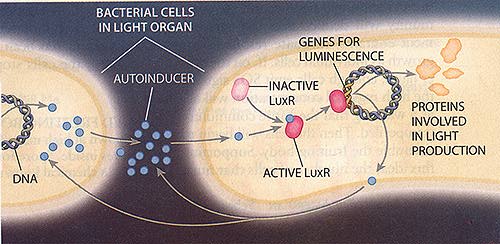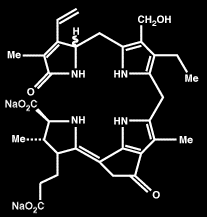Bioluminescence in the Deep Sea
Biology 342 Fall 2010
Author: Esther Ladizinsky
Mechanism
As with ontogeny, the distinction between passive (symbiont-dependent) and active (independent of a symbiont) bioluminescence is important in the mechanism by which organisms accomplish their luminosity.
Passive
When an animal has a symbiotic relationship with a luminescent bacteria to attain its glow, one may wonder: where exactly are these bacteria, and how did they get there? As it turns out, animals and their symbionts become acqu ainted very early in development (for more details, see Ontogeny). The bacteria themselves utilize the luciferin-luciferase system in a set of encoded genes called the Lux operon. The operon regulates like a switch, either activating or deactivating the system (1)... but what causes the bacteria to flip the switch?
ainted very early in development (for more details, see Ontogeny). The bacteria themselves utilize the luciferin-luciferase system in a set of encoded genes called the Lux operon. The operon regulates like a switch, either activating or deactivating the system (1)... but what causes the bacteria to flip the switch?
In testing the luminescent qualities of V. fischeri bacteria, symbiont of the squid E. scolopes, some bizarre behavior was observed: though they all contain the Lux operon and the luciferin system, the bacteria only activated the pathway if their population was at a certain density. This led to the conclusion that these bacteria practice a kind of cell-cell communication based on whether or not they can detect neighbors in their medium—this mechanism is referred to as quorum sensing (2), and sheds a little light (buh-dum-shing!) into the phenomenon of limited juvenile luminosity discussed in the Ontogeny section.
Active
If an animal is not bioluminescing with the help of symbiotic bacteria, it must depend on its own chemoluminescence—light generated by the energy released in a chemical reaction—at its own expense. Most animals accomplish this via luciferins, (Latin: light-bringer, chemical structure pictured left) pigments; with the enzyme luciferase catalyzing the reaction, luciferin is oxidized to emit energy in the form of light. This reaction has expends very little of its energy in thermal form—a “cold light.” Luciferins are located in the light-producing organs, which vary extensively from animal to animal. Typically they are composed of cells containing luminescent vesicles, called photocytes; these cells can be concentrated in a specific areas (like on the deceptive belly of a cookie-cutter shark) or dispersed widely on the organism (like flashy firefly squid).
How active is this active bioluminescence? Some fish luminesce when threatened or otherwise aroused; some squids, certainly, glow vibrantly at their mating time. As it turns out, the majority of multi-cellular organisms control their own luminosity. But perhaps the word “control” is misleading; it's the same sort of control we have over our heart rate or sweating, that of the sympathetic nervous system. In this way, the organism controls luminescence neurally, by way of neurotransmitters such as nor-adrenaline (3).